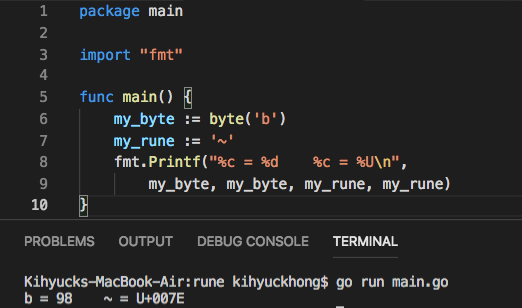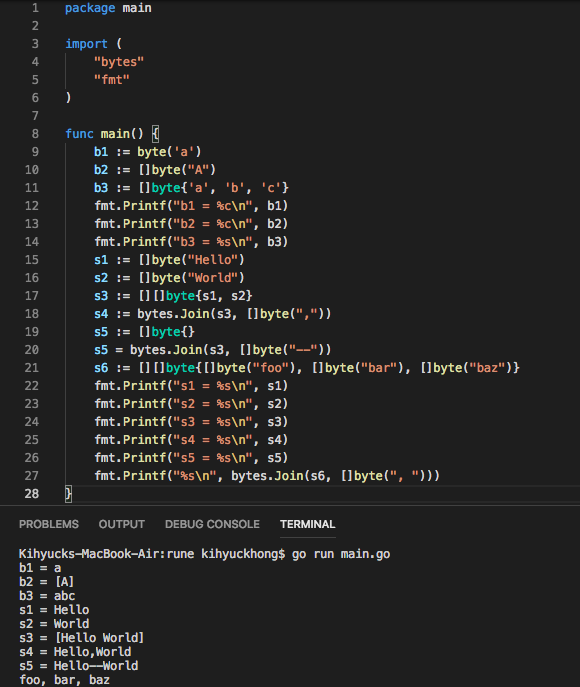GoLang Tutorial - byte and rune
Golang has integer types called byte and rune that are aliases for uint8 and int32 data types, respectively.
In Go, the byte and rune data types are used to distinguish characters from integer values.
In Go, there is no char data type. It uses byte and rune to represent character values.
The byte data type represents ASCII characters while the rune data type represents a more broader set of Unicode characters that are encoded in UTF-8 format.
In Go, Characters are expressed by enclosing them in single quotes like this: 'a'.
The default type for character values is rune, which means, if we don't declare a type explicitly when declaring a variable with a character value, then Go will infer the type as rune.
var myLetter = 'R' // Type inferred as rune which is the default type for character values
We can create a byte variable by explicitly specifying the type:
var anotherLetter byte = 'B'
Both byte and rune data types are essentially integers.
For example, a byte variable with value 'a' is converted to the integer 97 while a rune variable with a unicode value '~' is converted to the corresponding unicode codepoint U+007E, where U+ means unicode and the numbers are hexadecimal, which is essentially an integer.

Join concatenates the elements of input slice to create a new byte slice. In other words, Join concatenates the elements of s to create a new byte slice. The separator sep is placed between elements in the resulting slice:
Join(s [][]byte, sep []byte) []byte

The code: bytes_join.go
Go Tutorial
- GoLang Tutorial - HelloWorld
- Calling code in an external package & go.mod / go.sum files
- Workspaces
- Workspaces II
- Visual Studio Code
- Data Types and Variables
- byte and rune
- Packages
- Functions
- Arrays and Slices
- A function taking and returning a slice
- Conditionals
- Loops
- Maps
- Range
- Pointers
- Closures and Anonymous Functions
- Structs and receiver methods
- Value or Pointer Receivers
- Interfaces
- Web Application Part 0 (Introduction)
- Web Application Part 1 (Basic)
- Web Application Part 2 (Using net/http)
- Web Application Part 3 (Adding "edit" capability)
- Web Application Part 4 (Handling non-existent pages and saving pages)
- Web Application Part 5 (Error handling and template caching)
- Web Application Part 6 (Validating the title with a regular expression)
- Web Application Part 7 (Function Literals and Closures)
- Building Docker image and deploying Go application to a Kubernetes cluster (minikube)
- Serverless Framework (Serverless Application Model-SAM)
- Serverless Web API with AWS Lambda
- Arrays vs Slices with an array left rotation sample
- Variadic Functions
- Goroutines
- Channels ("<-")
- Channels ("<-") with Select
- Channels ("<-") with worker pools
- Defer
- GoLang Panic and Recover
- String Formatting
- JSON
- SQLite
- Modules 0: Using External Go Modules from GitHub
- Modules 1 (Creating a new module)
- Modules 2 (Adding Dependencies)
- AWS SDK for Go (S3 listing)
- Linked List
- Binary Search Tree (BST) Part 1 (Tree/Node structs with insert and print functions)
- Go Application Authentication I (BasicAuth, Bearer-Token-Based Authentication)
- Go Application Authentication II (JWT Authentication)
Ph.D. / Golden Gate Ave, San Francisco / Seoul National Univ / Carnegie Mellon / UC Berkeley / DevOps / Deep Learning / Visualization